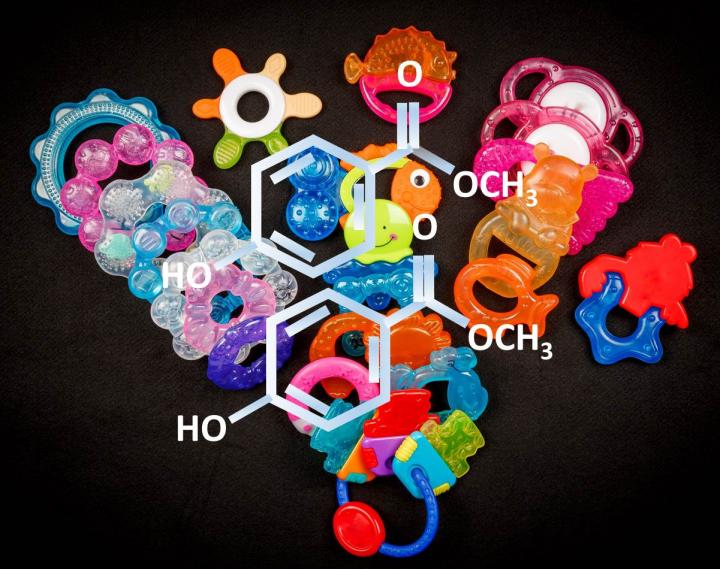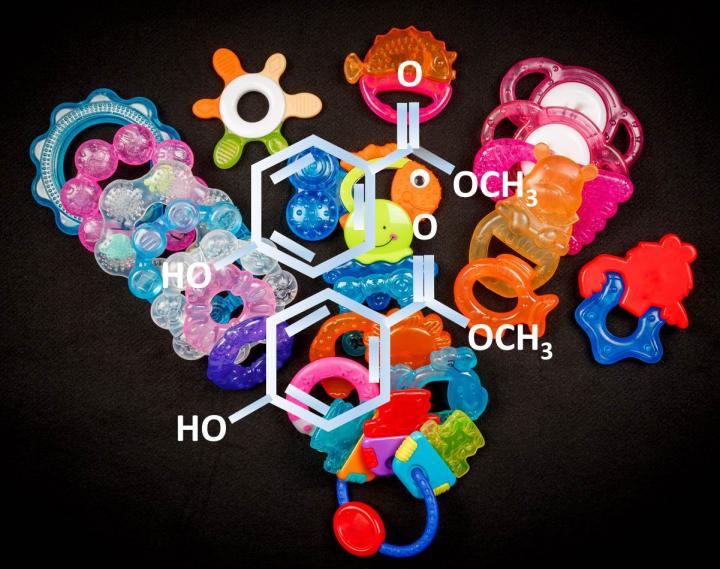
Credit: American Chemical Society
Bisphenol-A (BPA), parabens and antimicrobials are widely used in personal care products and plastics. The U.S. and other governments have banned or restricted some of these compounds' use in certain products for babies and kids. But the compounds' presence in and leaching from teethers hasn't been thoroughly investigated. Now a study in the ACS journal Environmental Science & Technology reports that all tested plastic teethers contained BPA and other endocrine-disruptors that leached at low levels.
Studies have shown that in animals, endocrine-disrupting compounds (EDCs) — which include BPA, parabens and antimicrobials — can potentially interfere with hormones and have harmful developmental, reproductive and neurological effects. As a result, the European Commission in 2011 restricted the use of BPA in baby bottles. The U.S. followed suit a year later, banning it from baby bottles, and also from children's drinking cups. Some manufacturers say they have started reducing BPA and other EDCs in additional products, even those not made for children. But very few if any studies have investigated whether the compounds are used to make teethers and if the compounds leach out of these products, which are designed to soothe babies' gums when their teeth come in. Kurunthachalam Kannan and colleagues wanted to see if the products contained EDCs and if the compounds could migrate out.
The researchers analyzed 59 solid, gel-filled or water-filled teethers purchased online in the U.S. for 26 potential endocrine-disrupting chemicals. Although most of the products were labeled BPA-free or non-toxic, all of them contained BPA. In addition, the researchers detected a range of different parabens and the antimicrobials triclosan and triclocarban in most of the teethers. The study also showed that the compounds leached out of the products' surfaces into water. Based on estimates of average use time and the body weight of a 12-month-old baby, calculations suggest that exposure to BPA and other regulated EDCs in teethers would be lower than the European standards for temporary tolerable daily intake levels. However, these thresholds are set for individual compounds. Current regulations do not account for the accumulation of multiple EDCs, note the researchers. Additionally, not all chemicals measured in the study are regulated. The researchers say the findings could be used to develop appropriate policies to protect infants from exposure to potentially toxic chemicals found in teethers.
###
The paper's abstract will be available on Dec. 7 here: http://pubs.acs.org/doi/abs/10.1021/acs.est.6b04128
The American Chemical Society is a nonprofit organization chartered by the U.S. Congress. With nearly 157,000 members, ACS is the world's largest scientific society and a global leader in providing access to chemistry-related research through its multiple databases, peer-reviewed journals and scientific conferences. Its main offices are in Washington, D.C., and Columbus, Ohio.
To automatically receive news releases from the American Chemical Society, contact [email protected].
Follow us: Twitter Facebook
Media Contact
Michael Bernstein
[email protected]
202-872-6042
@ACSpressroom
http://www.acs.org
############
Story Source: Materials provided by Scienmag






